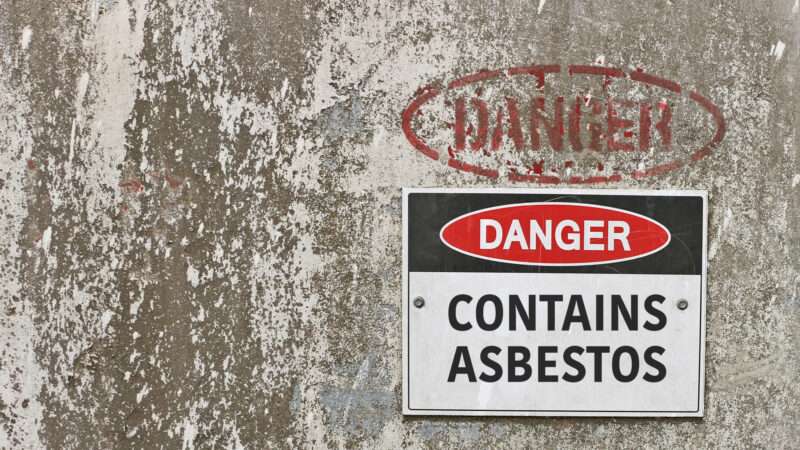
Reason reported in October that the federal government owns millions of square feet of unused office space. Watchdog agencies have long recommended that the government sell off some of its unused real estate, both to save money and to stimulate the property tax base by offloading those buildings to the private sector.
But good luck selling them off when you can't even show whether or not they contain dangerous levels of asbestos.
That's the finding of a report released this week by the Government Accountability Office (GAO). The GAO reviewed the General Services Administration's (GSA) policy on environmental contaminants in federal properties, since the GSA "may be legally responsible for the cleanup of environmental contaminants on federal properties it manages" if a building is sold. If an agency wants to get rid of an unneeded building, "the agency must notify GSA of certain environmental contaminants, so that the contamination can either be properly cleaned up before disposal or disclosed to the next owner."
"Federal accounting standards require agencies responsible for environmental contamination to estimate future environmental cleanup costs and to report such costs as environmental liabilities in their annual financial statements," the report notes. Ninety-five percent of the GSA's liabilities are sorted into asbestos and non-asbestos, and its liability estimates have ranged in recent years from $1.8 billion to $2 billion annually.
Asbestos is a fibrous material resistant to heat, which made it an ideal candidate for use as building insulation. Unfortunately, when disturbed, asbestos fibers are highly toxic and can cause respiratory diseases like lung cancer and mesothelioma; the Environmental Protection Agency (EPA) banned its use in new construction in 1989.
Because the danger arises from disturbing it, though, it's not always necessary to remove existing asbestos: "Undamaged asbestos that is properly managed in place poses little health risk," according to the EPA. "If done improperly, removing asbestos has the potential to create a greater health risk than leaving it undisturbed." The same is true of lead-based paint.
As such, GSA policy "requires a baseline asbestos inspection for each building built before 1998, along with re-inspection surveys every 5 years, unless a previous inspection indicates no asbestos in the building," according to the GAO report. "The policy also requires annual surveillance of buildings with asbestos, which is the process of walking through a facility and visually noting any changes in asbestos condition."
But the GSA has been incredibly lax with these inspections. The report finds that the "GSA has not completed asbestos inspections required by its asbestos management policy for approximately two-thirds of buildings within the last 5 years." According to the GSA's own data, 638 out of 955 buildings were out of compliance with the policy. That total "includes 228 buildings that do not have a known date of last inspection and 410 buildings whose last inspection was not within the last 5 years"; of those 410, "214 last had an inspection more than 10 years ago."
The report found that "15 of the 22 property sites GSA disposed of during fiscal years 2018 through 2022 likely included asbestos or non-asbestos contaminants." The GSA countered that this was no big deal, since the agency "is generally allowed to sell or convey properties with such liabilities in their current state, or 'as-is,' with required disclosures," and agency officials "target buyers—such as commercial developers—who understand the risks and are not concerned with the presence of asbestos or lead-based paint."
But the report also found that the presence of potential "hazardous releases," like contaminated soil or groundwater, does affect the amount a buyer is willing to pay for a property. "Property developers who bought GSA surplus property between fiscal years 2018 and 2022 told us that the presence of certain environmental contaminants can affect the property's value and influence the price they are willing to pay," the report says, including in some cases the presence of asbestos. "These buyers said that, depending on the circumstance, they may bid lower for properties with contaminants than those without, partly to offset the necessary cleanup expenses. In addition, these buyers indicated that environmental issues can limit who is willing to buy the property."
In response to the report, the GSA indicated that it was in the process of revising its policy, favoring a more risk-based approach that prioritized annual surveillance and only required further testing when asbestos has degraded or been disturbed. But the GAO report notes that this may be "less effective, because annually reviewing the condition of asbestos relies on having a current asbestos inventory, developed from the more rigorous asbestos inspections."
In other words, the GSA is unable to adopt a less rigorous approach because of how lax it has been with its inspections and record keeping.
The post The Federal Government Doesn't Know How Many of Its Buildings Contain Asbestos appeared first on Reason.com.







